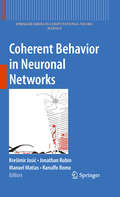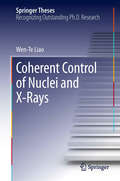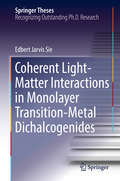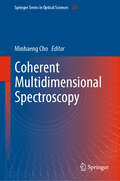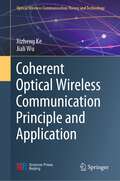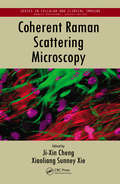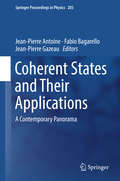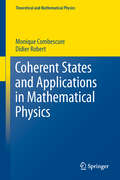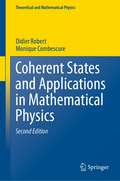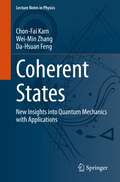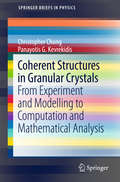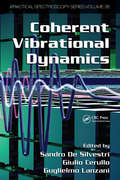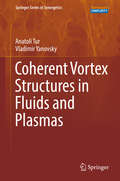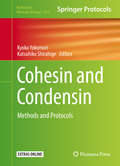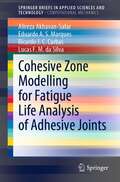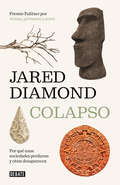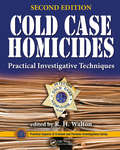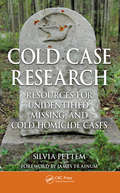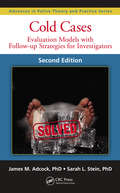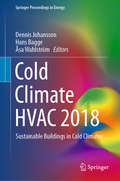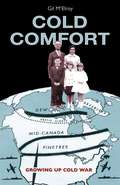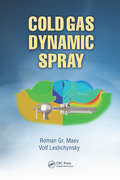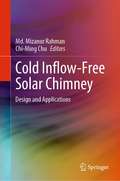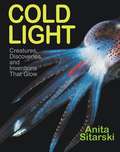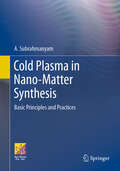- Table View
- List View
Coherent Behavior in Neuronal Networks (Springer Series in Computational Neuroscience #3)
by Jonathan Rubin Manuel Matias Ranulfo Romo Krešimir JosicRecent experimental research advances have led to increasingly detailed descriptions of how networks of interacting neurons process information. With these developments, it has become clear that dynamic network behaviors underlie information processing, and that the observed activity patterns cannot be fully explained by simple concepts such as synchrony and phase locking. These new insights raise significant challenges and offer exciting opportunities for experimental and theoretical neuroscientists. Coherent Behavior in Neuronal Networks features a review of recent research in this area from some of the world's foremost experts on systems neuroscience. The book presents novel methodologies and interdisciplinary perspectives, and will serve as an invaluable resource to the research community. Highlights include the results of interdisciplinary collaborations and approaches as well as topics, such as the interplay of intrinsic and synaptic dynamics in producing coherent neuronal network activity and the roles of globally coherent rhythms and oscillations in the coordination of distributed processing, that are of significant research interest but have been underrepresented in the review literature. With its cutting-edge mathematical, statistical, and computational techniques, this volume will be of interest to all researchers and students in the field of systems neuroscience.
Coherent Control of Nuclei and X-Rays (Springer Theses)
by Wen-Te LiaoNovel coherent light sources such as x-ray free-electron lasers open exciting prospects for the interaction of light with nuclei. The thesis "Coherent Control of Nuclei and X-rays" covers this still-developing field and proposes, in a daring attempt to revolutionize nuclear physics, three innovative schemes for taming nuclei using coherent effects. The theoretical explorations, which address control of nuclear quantum states, a nuclear memory for single photons in future photonic circuits, and optimized concepts for a nuclear clock, make use of new approaches at the borderline between nuclear physics and quantum dynamics. The result is a well written work, impressive in its stimulating style and promising ideas.
Coherent Light-Matter Interactions in Monolayer Transition-Metal Dichalcogenides (Springer Theses)
by Edbert Jarvis SieThis thesis presents optical methods to split the energy levels of electronic valleys in transition-metal dichalcogenides (TMDs) by means of coherent light-matter interactions. The electronic valleys found in monolayer TMDs such as MoS2, WS2, and WSe2 are among the many novel properties exhibited by semiconductors when thinned down to a few atomic layers, and have have been proposed as a new way to carry information in next generation devices (so-called valleytronics). These valleys are, however, normally locked in the same energy level, which limits their potential use for applications. The author describes experiments performed with a pump-probe technique using transient absorption spectroscopy on MoS2 and WS2. It is demonstrated that hybridizing the electronic valleys with light allows one to optically tune their energy levels in a controllable valley-selective manner. In particular, by using off-resonance circularly polarized light at small detuning, one can tune the energy level of one valley through the optical Stark effect. Also presented within are observations, at larger detuning, of a separate contribution from the so-called Bloch--Siegert effect, a delicate phenomenon that has eluded direct observation in solids. The two effects obey opposite selection rules, enabling one to separate the two effects at two different valleys.
Coherent Multidimensional Spectroscopy (Springer Series in Optical Sciences #226)
by Minhaeng ChoThis book will fulfill the needs of time-domain spectroscopists who wish to deepen their understanding of both the theoretical and experimental features of this cutting-edge spectroscopy technique. Coherent Multidimensional Spectroscopy (CMDS) is a state-of-the-art technique with applications in a variety of subjects like chemistry, molecular physics, biochemistry, biophysics, and material science. Due to dramatic advancements of ultrafast laser technologies, diverse multidimensional spectroscopic methods utilizing combinations of THz, IR, visible, UV, and X-ray radiation sources have been developed and used to study real time dynamics of small molecules in solutions, proteins and nucleic acids in condensed phases and membranes, single and multiple excitons in functional materials like semiconductors, quantum dots, and solar cells, photo-excited states in light-harvesting complexes, ions in battery electrolytes, electronic and conformational changes in charge or proton transfer systems, and excess electrons and protons in water and biological systems.
Coherent Optical Wireless Communication Principle and Application (Optical Wireless Communication Theory and Technology)
by Xizheng Ke Jiali WuThis book presents the key technologies of coherent optical wireless communication, covers topics such as beam coupling, signal optical polarization control and distorted wavefront correction. It discusses the principle of coherent optical communication and heterodyne detection conditions. In this book, the array coupling receiving technology and large aperture coupling technology are introduced to realize the spatial optical fiber coupling; simulated annealing algorithm, particle swarm optimization algorithm and SPO algorithm are used to control the polarization state of the signal beam; and the correction of distorted wavefront of the signal beam by adaptive optics technology and wavefront sensorless adaptive optics technology are analyzed, and the influence of beam mode on coherent detection performance is elaborated. Both theoretical deduction and experimental results are included in this book, which can help readers further understand the theoretical knowledge.
Coherent Raman Scattering Microscopy (Series in Cellular and Clinical Imaging)
by Ji-Xin Cheng Xiaoliang Sunney XieThe First Book on CRS MicroscopyCompared to conventional Raman microscopy, coherent Raman scattering (CRS) allows label-free imaging of living cells and tissues at video rate by enhancing the weak Raman signal through nonlinear excitation. Edited by pioneers in the field and with contributions from a distinguished team of experts, Coherent Raman Sc
Coherent States and Their Applications: A Contemporary Panorama (Springer Proceedings in Physics #205)
by Fabio Bagarello Jean-Pierre Gazeau Jean-Pierre AntoineCoherent states (CS) were originally introduced in 1926 by Schrödinger and rediscovered in the early 1960s in the context of laser physics. Since then, they have evolved into an extremely rich domain that pervades virtually every corner of physics, and have also given rise to a range of research topics in mathematics.The purpose of the 2016 CIRM conference was to bring together leading experts in the field with scientists interested in related topics, to jointly investigate their applications in physics, their various mathematical properties, and their generalizations in many directions. Instead of traditional proceedings, this book presents sixteen longer review-type contributions, which are the outcome of a collaborative effort by many conference participants, subsequently reviewed by independent experts.The book aptly illustrates the diversity of CS aspects, from purely mathematical topics to physical applications, including quantum gravity.
Coherent States and Applications in Mathematical Physics (Theoretical and Mathematical Physics)
by Didier Robert Monique CombescureThis book presents the various types of coherent states introduced and studied in the physics and mathematics literature and describes their properties together with application to quantum physics problems. It is intended to serve as a compendium on coherent states and their applications for physicists and mathematicians, stretching from the basic mathematical structures of generalized coherent states in the sense of Perelomov via the semiclassical evolution of coherent states to various specific examples of coherent states (hydrogen atom, quantum oscillator, ...).
Coherent States and Applications in Mathematical Physics (Theoretical and Mathematical Physics)
by Didier Robert Monique CombescureThis second edition of the outstanding monograph on coherent states by Combescure and Robert published in 2012 is enriched with figures, historical information and numerical simulations and enlarged with five new chapters presenting important rigorous results obtained in the recent years. The new chapters include various applications such as to the time dependent Schroedinger equation and the Ehrenfest time, to the growth of norms and energy exchanges, to chaotic systems and classical systems with quantum ergodic behavior, and to open quantum systems, and to adiabatic decoupling for multicomponent systems Overall, this book presents the various types of coherent states introduced and studied in the physics and mathematics literature and describes their properties together with application to quantum physics problems. It is intended to serve as a compendium on coherent states and their applications for physicists and mathematicians, stretching from the basic mathematical structures of generalized coherent states in the sense of Perelomov via the semiclassical evolution of coherent states to various specific examples of coherent states (hydrogen atom, quantum oscillator, etc.). It goes beyond existing books on coherent states in terms of a rigorous mathematical framework
Coherent States: New Insights into Quantum Mechanics with Applications (Lecture Notes in Physics #1011)
by Da-Hsuan Feng Chon-Fai Kam Wei-Min ZhangThis book presents the essential ideas of coherent states and provides researchers and graduate students with the necessary tools for various applications of generalized coherent state theory. These applications include areas such as quantum information, quantum phase transitions, quantum many-body systems, quantum chaos, and quantum open systems. The aim of the book is to show how coherent states can be applied to an extensive range of physical systems. The authors provide many exercises at the end of each chapter to enhance the mastery of the subject. Throughout the first seven chapters, only an understanding of elementary quantum mechanics is assumed, and for the last six chapters, some basic knowledge of group theory is requested to follow the arguments.
Coherent Structures in Granular Crystals: From Experiment And Modelling To Computation And Mathematical Analysis (SpringerBriefs in Physics)
by Panayotis G. Kevrekidis Christopher ChongThis book summarizes a number of fundamental developments at the interface of granular crystals and the mathematical and computational analysis of some of their key localized nonlinear wave solutions. The subject presents a blend of the appeal of granular crystals as a prototypical engineering tested for a variety of diverse applications, the novelty in the nonlinear physics of its coherent structures, and the tractability of a series of mathematical and computational techniques to analyse them. While the focus is on principal one-dimensional solutions such as shock waves, traveling waves, and discrete breathers, numerous extensions of the discussed patterns, e.g., in two dimensions, chains with defects, heterogeneous settings, and other recent developments are discussed. The emphasis on the subject was motivated by models in condensed matter physics, ferroelectrics, high energy physics, and statistical mechanics, leading to developments in mathematical analysis, numerical computation and insights on the physical aspects of the model. The book appeals to researchers in the field, as well as for graduate and advanced undergraduate students. It will be of interest to mathematicians, physicists and engineers alike.
Coherent Vibrational Dynamics
by Guglielmo Lanzani Giulio Cerullo Sandro De SilvestriRemarkable developments in the spectroscopy field regarding ultrashort pulse generation have led to the possibility of producing light pulses ranging from 50 to5 fs and frequency tunable from the near infrared to the ultraviolet range. Such pulses enable us to follow the coupling of vibrational motion to the electronic transitions in molecules and
Coherent Vortex Structures in Fluids and Plasmas (Springer Series in Synergetics)
by Anatoli Tur Vladimir YanovskyThis monograph introduces readers to the hydrodynamics of vortex formation, and reviews the last decade of active research in the field, offering a unique focus on research topics at the crossroads of traditional fluids and plasmas. Vortices are responsible for the process of macroscopic transport of momentum, energy and mass, and are formed as the result of spontaneous self-organization. Playing an important role in nature and technology, localized, coherent vortices are regularly observed in shear flows, submerged jets, afterbody flows and in atmospheric boundary layers, sometimes taking on the form of vortex streets. In addition, the book addresses a number of open issues, including but not limited to: which singularities are permitted in a 2D Euler equation besides point vortices? Which other, even more complex, localized vortices could be contained in the Euler equation? How do point vortices interact with potential waves?
Cohesin and Condensin: Methods and Protocols (Methods in Molecular Biology #1515)
by Kyoko Yokomori Katsuhiko ShirahigeThe volume provides comprehensive, state-of-the-art experimental techniques that are now available to dissect the molecular mechanisms of regulation and function of cohesin and the related factor condensin in vitro and in vivo across different model organisms, as well as in human cells. Cohesin and Condensin: Methods and Protocols is divided into three parts: Part I explores various in vitro and in vivo systems used to study the fundamental mechanism of cohesin regulation in mitosis and meiosis; Part II summarizes experimental systems in a variety of organisms that are used to address interphase functions of cohesin and Nipbl in gene regulation and chromatin interaction, ribosome biogenesis and DNA repair, which contribute significantly to cohesion-associated disorders; Part III covers related condensin complex and describes techniques to study its role in mitosis and interphase. Written in the highly successful Methods in Molecular Biology series format, chapters include introductions to their respective topics, lists of the necessary materials and reagents, step-by-step, readily reproducible laboratory protocols, and tips on troubleshooting and avoiding known pitfalls. Cutting-edge and thorough, Cohesin and Condensin: Methods and Protocols is a valuable resource for diverse audiences with interests in the relationship between chromatin organization and genomic functions.
Cohesive Zone Modelling for Fatigue Life Analysis of Adhesive Joints (SpringerBriefs in Applied Sciences and Technology)
by Lucas F. da Silva Alireza Akhavan-Safar Eduardo A. Marques Ricardo J. CarbasThis book explains the numerical method for fatigue life analysis of adhesive joints using the CZM technique. CZM is a robust approach that is widely used for failure analysis of adhesive joints exposed to various stress conditions including fatigue. In this book, various aspects of the numerical evaluation of adhesive bonds using CZM are discussed. First of all, it is explained how different load and environmental parameters influence the service life of adhesive connections. Various types of CZM shapes and their applications are then discussed. It was answered how different parameters of a CZM should be defined. It is also discussed which CZM form should be used for each condition. The book then describes how the CZM parameters should be degraded to simulate the cyclic loading behavior of bonded structures. Various CZM strategies for the fatigue life assessment of adhesive joints are discussed. The book presents various techniques that can be followed for the simulation of load cycles for both high-cycle and low-cycle fatigue regimes based on the concepts of the CZM. Details of numerical methods to be considered in the FE software for the fatigue life assessment of adhesives with CZM are also described in this book. Finally, some numerical examples using CZM are also provided.
Colapso: Por qué unas sociedades perduran y otras desaparecen
by Jared DiamondJared Diamond se pregunta cómo unas sociedades que han desaparecido sin apenas dejar huella de su evolución han alcanzado una próspera civilización material y cultural. A través de sus amplios conocimientos en sociología, economía, lingüística, biología o antropología, Diamond trata de explicar la desaparición de sociedades del pasado y se pregunta si podemos aprender la lección y evitar desastres parecidos en el futuro. El punto de partida es una rigurosa investigación de los casos de culturas que no han perdurado: historias trágicas como la de los mayas, la de la Isla de Pascua o la de los indios anasazi en Norteamérica; historias menos terribles como la de Islandia o de Japón, culturas que han sabido reaccionar con éxito a desafíos ambientales; historias también de vencedores y vencidos, como el caso de la República Dominicana y de Haití, dos pueblos que a pesar de compartir el mismo medio ambiente han evolucionado de modos muy distintos, y finalmente historias aún abiertas como las de China o Australia, que están buscando soluciones innovadoras a sus desafíos ecológicos y sociales. ¿Qué lección podemos aprender del pasado? ¿Está nuestro futuro en peligro? Las respuestas que ofrece este libro no son catastróficas, pero al mismo tiempo nos advierten de la urgencia de tomar decisiones cuanto antes si queremos seguir admirando las ruinas de otros pueblos que nos han precedido. Reseñas:«Uno de los proyectos intelectuales más significativos de nuestra generación.»The New York Times «En conjunto, Armas, gérmenes y acero y Colapso representan uno de los proyectos más importantes en los que se ha embarcado ningún intelectual de nuestra generación.»Gregg Easterbrook, The New York Time Book Review
Cold Case Homicides: Practical Investigative Techniques, Second Edition (Practical Aspects of Criminal and Forensic Investigations)
by R.H. WaltonThis book, now in its second edition, is the first and most exhaustive text covering the still growing popularity of cold case investigations which locate perpetrators and free the innocent. The new edition adds approximately 80 pages of content, including material on clandestine graves and investigating cold gang cases. The book merges theory with practice through the use of case histories, photographs, illustrations and checklists that convey essential, fundamental concepts while providing a strong, practical basis for the investigative process.
Cold Case Research Resources for Unidentified, Missing, and Cold Homicide Cases
by Silvia PettemCases in which all investigative leads appear to be exhausted are frustrating for both investigators and victims families. Cold cases can range from those only a few months old to others that go back for decades. Presenting profiles and actual case histories, Cold Case Research: Resources for Unidentified, Missing and Cold Homicide Cases illustrat
Cold Cases: Evaluation Models with Follow-up Strategies for Investigators, Second Edition (Advances in Police Theory and Practice)
by James M. Adcock Sarah L. SteinBecause the investigation of cold cases is usually an arduous and time-consuming task, most law enforcement agencies in the United States are not able to dedicate the resources necessary to support the cold case investigation process. However, when those cases are fully pursued and prosecuted, they often result in convictions and lengthy prison terms. Cold Cases: Evaluation Models with Follow-up Strategies for Investigators, Second Edition saves law enforcement time by providing detailed guidelines for determining if a cold case is solvable, and if so, how to organize, manage, and evaluate the investigation. It also provides techniques for developing investigative strategies to complement the evaluation process and resolve the crime.This second edition features a new revised model and methodology for investigating cold cases suitable for all police and public safety agencies—large or small, domestic or international. This new model is more expeditious and convenient for departments that have less manpower and experience in dealing with cold cases. It emphasizes the prioritization of cold cases based on the availability of physical evidence and the chances of deriving matches from said evidence and an identified person of interest.Additional topics covered in the second edition include: How cases go cold Strategies for creating a cold case unit Cold case investigations in a Dutch educational environment—a chapter written by members of the Dutch Police Academy New forensic science technologies, including DNA, CODIS, and AFIS Case studies demonstrating advances in suspectology Strategies for effective investigative interviewing Challenges posed by staged crime scenes in cold cases How to craft a cold case evaluation report The expert authors of this book maintain The Center for the Resolution of Unresolved Crimes and conduct training and consulting worldwide. Their practical book is designed to help law enforcement agencies resurrect long-forgotten cases, bringing closure to victims and holding accountable those who are responsible. This book is part of the Advances in Police Theory and Practice series
Cold Climate HVAC 2018: Sustainable Buildings in Cold Climates (Springer Proceedings in Energy)
by Dennis Johansson Hans Bagge Åsa WahlströmThis volume presents the proceedings of the 9th Cold Climate HVAC conference, which was held in Kiruna, Sweden in 2018. The conference highlighted key technologies and processes that allow scientists, designers, engineers, manufacturers and other decision makers in cold climate regions to achieve good indoor environmental quality (IEQ) with a minimum use of energy and other resources. The conference addressed various technical, economic and social aspects of buildings and HVAC systems in new and renovated buildings. This proceedings volume gathers peer-reviewed papers by a diverse and international range of authors and showcases perspectives and practices in cold climate building design from around the globe. The following major aspects, which include both fundamental and theoretical research as well as applications and case studies, are covered: (1) Energy and power efficiency and low-energy buildings; (2) Renovating buildings; (3) Efficient HVAC components; (4) Heat pumps and geothermal systems; (5) Municipal and city energy systems; (6) Construction management; (7) Buildings in operation; (8) Building simulation; (9) Reference data; (10) Transdisciplinary connections and social aspects; (11) Indoor environments and health; (12) Moisture safety and water damage; (13) Codes, regulations, standards and policies; and (14) Other aspects of buildings in cold climates.
Cold Comfort
by Gil McelroyWhen his father died, award-winning poet and curator Gil McElroy was given a box of photographs that documented his father's military career. Beginning in the Second World War and continuing right through to the end of the Cold War, the senior McElroy staffed Canada's network of electronic defence, including the Distant Early Warning Line - a network of radar stations stretching along the Arctic coast from Alaska to Baffin Island. Established in the early 1950s, the DEW Line provided advance warning of an aircraft or missile attack. There, servicemen lived in isolated radar stations, watching surveillance screens for the telltale blips that threatened nuclear annihilation.McElroy reflects on the sacrifices these men made, living away from their families for great lengths of time - for the "greater good" of protecting North American airspace and Western values.At the same time, Cold Comfort follows McElroy's experience of growing up as an itinerant military brat, who moved from one posting to another, and the military family's attempts to hold together in the face of the father's absence. Cold Comfort also explores the utter enigma that was the author's father. Examining the contents of the box of photographs, image by image, McElroy attempts to come to terms with the mysterious photographer, a man better understood by his military compatriots than by his own family.Further, Cold Comfort provides the backstory to McElroy's most recent collection of poems, Ordinary Time, which offers an unsettling history of the utter failures of these remote surveillance technologies to make "our" world either better known or reliably predictable.
Cold Gas Dynamic Spray
by Roman Gr. Maev Volf LeshchynskyYour Guide to Advanced Cold Spray TechnologyCold Gas Dynamic Spray centers on cold gas dynamic spray (or cold spray-CS) technology, one of the most versatile thermal spray coating methods in materials engineering, and effectively describes and analyzes the main trends and developments behind the spray (coating) techniques. The book combines theory
Cold Inflow-Free Solar Chimney: Design and Applications
by Md. Mizanur Rahman Chi-Ming ChuThis book highlights the design of a new type of solar chimney that has lower height and bigger diameter, and discusses its applications. The bigger diameter chimneys are introduced showing cold inflow phenomena that significantly reduced the performance of solar chimney. The cold inflow-free operation of solar chimneys restores the draft losses and enhances the performance of the solar chimneys. Numerical and experimental investigation results will be presented to highlight the performance of cold inflow-free solar chimney performance. In addition, this book covers the important basic design parameters that affect the design of solar chimney for different applications, mainly, solar chimney-assisted ventilation for passive cooling and power generation system.
Cold Light: Creatures, Discoveries, and Inventions That Glow
by Anita SitarskiLuminescence sheds light on the adventure of science. Scientists and many others have explored the science and wonder of cold light--the chemistry of animals and things that make light but not heat. A seventeenth-century alchemist tried to turn a stone into gold. He failed, but the stone glowed in the dark instead. The alchemist began to mold the first luminescent objects. A light also came on one night for the famous chemist Robert Boyle. After he saw a raw chicken glowing in his kitchen, he began his own research into luminescence. With light humor, Anita Sitarski brings the thrill of discovery to life as she recounts the stories of the alchemist, chemist Robert Boyle, the adventurers who first saw bizarre creatures glowing in the depths of the sea, and others. Awe-inspiring, full-color photographs accompany the compelling, fact-filled text in these scientific explorations.
Cold Plasma in Nano-Matter Synthesis: Basic Principles and Practices
by A. SubrahmanyamThis book describes the basic principles and techniques of cold plasma to synthesize nanomaterials, emphasizing the fundamentals. Nanotechnology has matured enough to make inroads into the industry. “Quantum size effects” is the basis of the exotic properties of nanomaterials. The shapes and the size distribution dictate the properties of the nano-matter. The demands of the synthesis technique are to produce nano-matter with uniform size, repeatable shapes, uniform size distribution, stability of the nanostructures (reaching thermodynamic equilibrium), reproducibility of the particle sizes, and reliability of the process. These demands can be met when the synthesis technique has precise control over the process parameters. Cold plasma techniques possess all the requirements of the needs of nanomaterial synthesis. The cold plasma, an evolving field, has been established to be the most powerful tool not only for micro-electronics (both in the deposition and etching) but in many areas like health care, medicine, agriculture, food processing, etc. The book’s primary emphasis is to explain the basic principles and concepts of cold plasma in nanomaterial synthesis. The target audience is undergraduate and graduate students learning nanomaterial synthesis and plasma technology. It is hoped that this book also is a good source of reference for practicing scientists and engineers involved in synthesizing nanomaterials and nanostructures in the industry.
